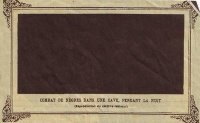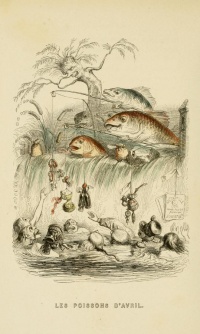French humor
From The Art and Popular Culture Encyclopedia


Illustration: Mona Lisa Smoking a Pipe by Eugène Bataille


|
Related e |
|
Featured: |
In Europe, the theatrical genre-like comedy developed in the Greco-Roman antiquity, much like the tragedy theaters built in the Roman Empire. During the Middle Ages, theater plays in the street, in the form of mystery plays, fabliaux, farces, soties and mimes were more or less inspired by antique survivals genres like Atellan.
In France during the 17th century under Louis XIV, the Italian influence and Molière began to recognize the comedy theater as an art in itself and not as a subgenre compared to the tragedy. From the 18th to the 19th century, comedy would continue to incorporate opera and comédie-ballet and become opéra comique. Comedy would also inspire the Operetta (Offenbach) in the middle of the 19th century. At the beginning of the 20th century, operettas were transformed into musical theatre. Bourvil and Fernandel started as operetta singers while Louis de Funès started as a music-hall pianist.
Contents |
Histiriography
Two works document French humor, or the link between humor and avant-garde: A History of Derision, an aborted project by Atlas Press and Le Rire de résistance, a 2007 book by French author Jean-Michel Ribes.
Black comedy
- Alphonse Allais
- Pierre Bourgeade
- Alfred Jarry
- Octave Mirbeau
- Gisèle Prassinos
- Anthology of Black Humor (1940) by André Breton
French humor magazine
Cinema
French comedy films are comedy films produced in France. Comedy is the most popular French genre in cinema.
Comic films began to appear in significant numbers during the era of silent films, roughly 1895 to 1930. The visual humour of many of these silent films relied on slapstick and burlesque.
Beginning of cinema
In 1892, before cinema was created, Émile Reynaud recognized several comedy cartoons, including Le Clown et ses chiens. Comic films began to appear in significant numbers during the era of silent films, placed from 1895 to 1930. The visual humour of many of these silent films relied on slapstick and burlesque. A very early comedy short was Watering the Gardener (1895) by the Lumière brothers. In his native France and throughout the world, Max Linder was a major comic feature and might qualify as the first true film star.
Georges Méliès, from theatre, created the first studio de cinéma. He also created many silent comedies. He had a homage in 2011 with the movie Hugo.
During the World War I, America obtained the monopoly of comedy movies with the 'silent film' (Charlie Chaplin, Laurel and Hardy) Only after sound was integrated into these performances (The Jazz Singer was released in 1927 in US) that comedy films started being produced in France from the 1930s.
Interwar and Occupation
When the sound entered cinema in 1927, comedy films returned to popularity, due to dialogue now being available for usage.
As the majority of France lived in rural areas during the 1930s, most films took place in similar areas.
1940s to 1970s
After the Second World War, French society went under many changes during the 1940s to the 1970s, and thus it had a big impact on the comedies of this period. A number of French comedians were able to find an English speaking audience in this period, including Fernandel, Bourvil, Louis de Funès and Jacques Tati.
From the 1970s to 1990s
At the beginning of the 1970s, new actors from the baby-boomer generation starred in comedy films. Some examples would be Gérard Depardieu, the Splendid troupe, Daniel Auteuil, Daniel Prévost, and Coluche.
Le Splendid
The 1970s to 1990s corresponded to the golden age of comedies created and played by le Splendid which have been very famous in the theatre industry.
1970s to 1980s
Comedies from the era tackled new social phenomena and were meant to provoke or shock audiences.
Provocation is present in multiple films, such as Going Places, La Grande Bouffe, Les Babas Cool, and Menage. In Santa Claus is a bastard, Santa Claus (who is traditionally portrayed as calm) is highly violent and vulgar, and brandishes a gun.
1980s to the 2000s
A new introduction of Francis Veber's concept arose during this period. 'Francois Pignon' and 'Francois Perrin' symbolized the stupider and more naive man triumphing over the smarter and "stronger" man due to luck.
The 2000s to present
The 2000s correspond to a transition: indeed, the Splendid troupe generation of the 1970s tends to give over to newcomers (Dany Boon, Jamel Debbouze, Omar Sy) who have become famous with 'one man shows'.
See also

